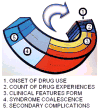Novel phenotype issues raised in cross-national epidemiological research on drug dependence
- PMID: 20201862
- PMCID: PMC3012560
- DOI: 10.1111/j.1749-6632.2009.05419.x
Novel phenotype issues raised in cross-national epidemiological research on drug dependence
Abstract
Stage-transition models based on the American Diagnostic and Statistical Manual (DSM) generally are applied in epidemiology and genetics research on drug dependence syndromes associated with cannabis, cocaine, and other internationally regulated drugs (IRDs). Difficulties with DSM stage-transition models have surfaced during cross-national research intended to provide a truly global perspective, such as the work of the World Mental Health Surveys Consortium. Alternative simpler dependence-related phenotypes are possible, including population-level count process models for steps early and before coalescence of clinical features into a coherent syndrome (e.g., zero-inflated Poisson [ZIP] regression). Selected findings are reviewed, based on ZIP modeling of alcohol, tobacco, and IRD count processes, with an illustration that may stimulate new research on genetic susceptibility traits. The annual National Surveys on Drug Use and Health (NSDUH) can be readily modified for this purpose, along the lines of a truly anonymous research approach that can help make NSDUH-type cross-national epidemiological surveys more useful in the context of subsequent genomewide association (GWAS) research and post-GWAS investigations with a truly global health perspective.
Conflict of interest statement
Conflicts of interest: The author declares no conflicts of interest.
Figures



References
-
- Gershon ES, Kelsoe JR, Kendler KS, Watson JD. Editorial: A Scientific Opportunity. Science, New Series. 2001;294(5544):957. - PubMed
-
- Reboussin BA, Anthony JC. Latent class marginal regression models for modelling youthful drug involvement and its suspected influences. Statistics in Medicine. 2001;20(4):623–639. - PubMed
-
- Storr CL, Zhou H, Liang KY, Anthony JC. Empirically derived latent classes of tobacco dependence syndromes observed in recent-onset tobacco smokers: epidemiological evidence from a national probability sample survey. Nicotine Tob Res. 2004;6(3):533–545. - PubMed
-
- Storr CL, Reboussin BA, Anthony JC. The Fagerström test for nicotine dependence: a comparison of standard scoring and latent class analysis approaches. Drug Alcohol Depend. 2005;80(2):241–250. - PubMed

